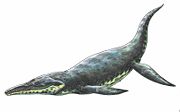
Kronosaurus
Encyclopedia
Kronosaurus is an extinct genus
of short-necked pliosaur
. It was among the largest pliosaurs, and is named after the leader of the Greek Titans
, Cronus
.
Period (Aptian
-Albian
).
The holotype
specimen of the species
K. queenslandicus was described by Longman in 1924, and is currently in the Queensland Museum
. Hampe described a second species, K. boyacensis, in 1992 from Colombia
.
and Liopleurodon
teeth. The combination of large size, conical shape and lack of cutting edges allows for easy identification of Kronosaurus teeth in Cretaceous deposits from Australia.
 Large, round bite-marks have been found on the skull of an Albian-age Australian elasmosaurid (Eromangasaurus
Large, round bite-marks have been found on the skull of an Albian-age Australian elasmosaurid (Eromangasaurus
) that could be from a Kronosaurus attack.
Genus
In biology, a genus is a low-level taxonomic rank used in the biological classification of living and fossil organisms, which is an example of definition by genus and differentia...
of short-necked pliosaur
Pliosaur
Pliosauroidea is an extinct clade of marine reptiles. Pliosauroids, also commonly known as pliosaurs, are known from the Jurassic and Cretaceous Periods. The pliosauroids were short-necked plesiosaurs with large heads and massive toothed jaws. These swimming reptiles were not dinosaurs but distant...
. It was among the largest pliosaurs, and is named after the leader of the Greek Titans
Titan (mythology)
In Greek mythology, the Titans were a race of powerful deities, descendants of Gaia and Uranus, that ruled during the legendary Golden Age....
, Cronus
Cronus
In Greek mythology, Cronus or Kronos was the leader and the youngest of the first generation of Titans, divine descendants of Gaia, the earth, and Uranus, the sky...
.
Discovery and species
Kronosaurus lived in the Early CretaceousCretaceous
The Cretaceous , derived from the Latin "creta" , usually abbreviated K for its German translation Kreide , is a geologic period and system from circa to million years ago. In the geologic timescale, the Cretaceous follows the Jurassic period and is followed by the Paleogene period of the...
Period (Aptian
Aptian
The Aptian is an age in the geologic timescale or a stage in the stratigraphic column. It is a subdivision of the Early or Lower Cretaceous epoch or series and encompasses the time from 125.0 ± 1.0 Ma to 112.0 ± 1.0 Ma , approximately...
-Albian
Albian
The Albian is both an age of the geologic timescale and a stage in the stratigraphic column. It is the youngest or uppermost subdivision of the Early/Lower Cretaceous epoch/series. Its approximate time range is 112.0 ± 1.0 Ma to 99.6 ± 0.9 Ma...
).
The holotype
Holotype
A holotype is a single physical example of an organism, known to have been used when the species was formally described. It is either the single such physical example or one of several such, but explicitly designated as the holotype...
specimen of the species
Species
In biology, a species is one of the basic units of biological classification and a taxonomic rank. A species is often defined as a group of organisms capable of interbreeding and producing fertile offspring. While in many cases this definition is adequate, more precise or differing measures are...
K. queenslandicus was described by Longman in 1924, and is currently in the Queensland Museum
Queensland Museum
The Queensland Museum is the state museum of Queensland. The museum currently operates four separate campuses; at South Brisbane, Ipswich, Toowoomba and Townsville.The museum is funded by the State Government of Queensland.-History:...
. Hampe described a second species, K. boyacensis, in 1992 from Colombia
Colombia
Colombia, officially the Republic of Colombia , is a unitary constitutional republic comprising thirty-two departments. The country is located in northwestern South America, bordered to the east by Venezuela and Brazil; to the south by Ecuador and Peru; to the north by the Caribbean Sea; to the...
.
Size issues
Body-length estimates had previously put the total length of Kronosaurus at 12.8 meters (43 feet). However, a recent study comparing fossil specimens of Kronosaurus to other pliosaurs suggests that the previous estimate was an exaggeration, with the true length probably being only 9–10 meters (30–33 feet).Teeth
The teeth of Kronosaurus are large in length (exceeding 7 cm - the largest up to 30 cm long with 12 cm crowns). However, they lack carinae (cutting edges) and the distinct trihedral (three facets) of PliosaurusPliosaurus
Pliosaurus is a genus of extinct marine reptile. It is included in the family Pliosauridae. Its diet would have included fish, squid and other marine reptiles. This genus has contained several species in the past but it currently consists of the type species P. brachydeirus, P. macromerus and P...
and Liopleurodon
Liopleurodon
Liopleurodon is a genus of large, carnivorous marine reptile belonging to the Pliosauroidea, a clade of short-necked plesiosaurs. Two species of Liopleurodon lived during the Callovian stage of the Middle Jurassic Period , while the third, L. rossicus, lived during the Late Jurassic...
teeth. The combination of large size, conical shape and lack of cutting edges allows for easy identification of Kronosaurus teeth in Cretaceous deposits from Australia.
Diet

Eromangasaurus
Eromangasaurus is an extinct genus of elasmosaurid known from northern Queensland of Australia.-Description:Eromangasaurus is known from the holotype QM F11050, a nearly complete but badly crushed skull and mandible...
) that could be from a Kronosaurus attack.
External links
- Genus Kronosaurus. The Plesiosaur Directory.

